No products in the cart.
Blog, potato (Solanum tuberosum)
Potato: The Story of Rozette
I was recently interviewed for the Free the Seed podcast, where we discussed the selection of our new potato variety Rozette. This blog post is a companion to that podcast.
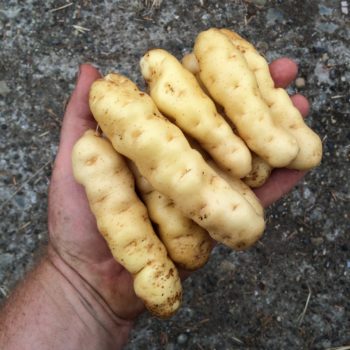
The Pacific Northwest has a few heirloom potatoes that precede large scale settlement of the area by Europeans. The most famous of these potatoes is Ozette. Ozette is a fingerling potato with deep eyes, a trait common in primitive potatoes from South America, but unusual in varieties that have been produced through modern breeding efforts. It has been grown by the Makah people of the northwest Olympic peninsula for a very long time. Its origin was a bit of a mystery, but a pretty compelling case has been made that it was an early introduction by the Spanish. A Spanish fort was established at Neah Bay in 1792. The Spanish didn’t stay, but they probably left behind the Ozette potato, which was adopted by the Makah. In a genetic analysis, Zhang (2010) found that Ozette is more closely related to Chilean potatoes than to the potatoes that had been introduced to the east coast from Europe.
I have grown Ozette since 2007 with the goal of using it for breeding. We live on the central coast of Washington about 60 miles from Lake Ozette, so Ozette is as close as we get to a local potato. I figured that 200 years of adaptation to this climate might make it a first rate choice for breeding. Unfortunately, it has many of the problematic features that plague the potato breeder: it is a very reluctant flowerer, poor at holding any flowers that do bloom, and to top it off, it is male sterile. The first hurdle was the biggest. Most years, Ozette does not flower here. About every three years, I would get a flower or two. I would hand pollinate those flowers and, a few days later, they would drop from the plant.
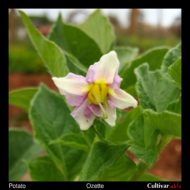 |
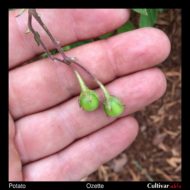 |
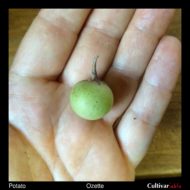 |
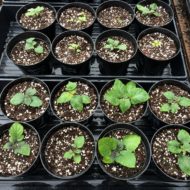 |
In 2016, I got half a dozen flowers at a time of year when I had a lot of other varieties in flower. I pollinated the Ozette flowers with bulk pollen from many varieties with blue or red flesh and I finally got a break: three of those flowers held on the plants and formed berries. Only two of the berries ultimately contained seeds, but I ended up with 176 seeds in total. I put 40 seeds in the freezer as insurance against incompetence (I’m growing those reserved seeds this year) and sowed the rest, ultimately getting tubers from 112 seedlings. I grew those seedlings in pots to produce minitubers and then planted the minitubers out in the field the next year for a full evaluation.
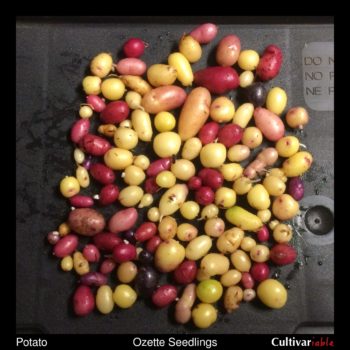
112 seedlings is not a lot to work with. Institutional potato breeders might select one variety from every 10,000 to 100,000 seedlings. I am much less stringent in my selection criteria, but I typically go through 400 to 500 seedlings to find a keeper. I was really hopeful about getting something worth keeping from these seedlings, considering how difficult it was to get the seed in the first place, but I wasn’t that optimistic. By my normal standards, I had about a 1 in 4 chance of finding a keeper in this batch. I was willing to be a bit less selective than usual though, particularly if I could find some seedlings that flowered better than Ozette. Those, at least, could be used to make additional crosses and mix the Ozette genetics around, although there is the further complication that Ozette is male sterile. That means that the seedlings could not be used to pollinate each other. Breeding with Ozette is a one-way trip in which the genetic contribution from Ozette will be reduced by half with each succeeding generation.
As is usually the case, most of the seedlings didn’t do that well in their field testing. Quite a few suffered badly from early blight. Other plants were healthy but remained small and produced poor yields. More than half of them were plain white potatoes with unremarkable shapes and I rarely keep white potatoes unless they have amazing flavor or unusual trait combinations. A large number of them produced knobbly tubers, which was interesting. I don’t usually see a high percentage of knobbly tubers from seed.
Because potatoes are polyploid and outbreeding, they have high genetic diversity. You never really know what you are going to see the first time you grow out progeny of a new variety. I had an idea of what I wanted though: a potato that retained the flavor and shape of Ozette but with some more color and better flowering. The ideal potato would have had both strong blue or red skin and flesh color. I got a lot of color in the seedlings, which was not a surprise since I pollinated the flowers with pollen collected from red and blue fleshed varieties. The more difficult trait was the Ozette shape. There were hints of that shape in a lot of the progeny, but almost none of them got both the deep eyes and fingerling shape.
After culling the weak, diseased, non-flowering, boring, irregular, and poorly yielding plants, I ended up with six that were worth some consideration, but there was only ever one obvious keeper.
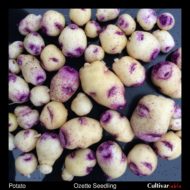 |
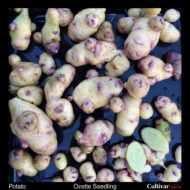 |
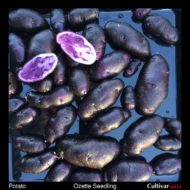 |
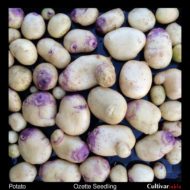 |
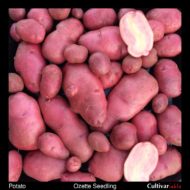 |
With any other parent, I would have culled candidate #1 without a second thought. The tubers were small – just reaching three inches. It was kind of pretty and I might have kept it for a breeding line if it had been a good flowerer, but it was only a little better than Ozette.
Candidate #2 was better in some ways. I selected it first because it was a good flowerer. It also had good flavor. Like many of the culled seedlings though, the tubers were a mess – very knobbly. I compromised on this one. I pollinated the evaluation plants with diverse pollen, collected a lot of seed, and then let it go to potato Heaven. So I have a few thousand true seeds from this seedling to try in the future. Those will be 1/4 Ozette genetics, so there is still a pretty good chance that I will get something Ozette-like out of them.
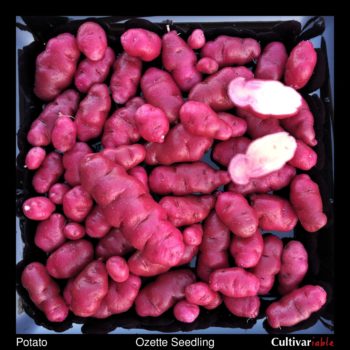
Candidate #3 looked good. I had high hopes for it. The color was great and the size was reasonable. It was a fair flowerer. Unfortunately, this potato was quite bitter, a sign of high glycoalkaloid content. That was reason enough to let it go, although I collected about a dozen berries from it, so I have some seed to try.
Candidate #4 didn’t thrill me until I tasted it. The flavor was great. The shape was sort of interesting – laterally compressed. It was a poor flowerer though, which is not good for breeding and that was the kiss of death for it.
Candidate #5 was close. The yield was good and tuber size was good. It was a poor flowerer, but better than Ozette. The color was nice. Unfortunately, the flavor just wasn’t that great. It was a nice looking but boring potato.
That left only one other candidate and I was pretty excited about it. The yield was good, it had an appealing shape and color, and it tasted very good. It wasn’t a particularly good flowerer, but it was better than Ozette at least. Unfortunately most of the tubers were pretty small. That worried me, but there were a couple of larger tubers that were true to the Ozette shape, so the only thing to do was grow out a second generation and see if they performed better.
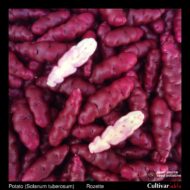 |
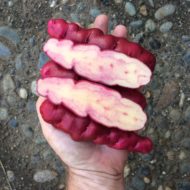 |
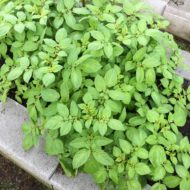 |
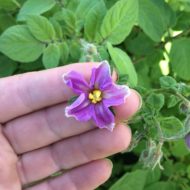 |
Happily, they did! Rozette met almost all the criteria I had hoped for. I would have preferred a bit more flesh color, but that is a small complaint. It would have been really nice if it were a more capable flowerer, but I can work with it. Overall, it is a really beautiful potato with good flavor. It is something that I think most people would be excited to pull out of the ground and that is really the main thing that I aim for.
I think Rozette is a good example for hobby potato breeders. Although it took a long time to get to seed, there is only one generation of selection in this variety. That is one of the nice things about plants that are propagated clonally; you don’t have to spend years stabilizing the variety. The 112 plants that I grew could fit into an area of about 15 x 15 feet. I won’t pretend that every variety is this easy, of course. Usually, I have multiple generations of crosses invested in varieties that I release and I was only able to get such diverse results in this case because I had hundreds of potato varieties to draw on for pollen. Still, sometimes you pull a winning lottery ticket on the first try. And, of course, if you are flexible in your criteria, you can often find something that you will be happy with even if it isn’t exactly what you wanted.

Thats awsome, im a mechanic by trade from the west coast of Norway, so we have a cool and wet spring-summer.
Outta pure chance i had 2x food potatoes that srouted and i thought “why not” so i dug out all the weeds from my flowerbed that hasent had flowers for at least 10years and planted the 2x potatoes. To my surprise that grew and grew into very nice looking plants with 8x white flowers on them. But what was the most fasanating was they had 5x “fruits” on them that got really dark green. i started to read up on this and picked the “fruits” when the stems started to dry up.
I smashed them by hand and cleaned the seeds as best i could and now 7mounths later just planted 1/4 of my seeds into little pots with dirt. I have no idea if they with grow or what they will be like, but its reallt gotten me into gardening, not the flower kind but plants with fruits and roots.
Getting the seeds is usually the hardest part. Part of the fun is not knowing what to expect from the seedlings. Good luck!
Update: Out of 9 little pots with three seeds in each iv gotten seven seedlings, i had to pluck out five seedlings were all three sprouted. I gave them 10 days and i left only the bigest ones in there pots.
Iv currently added 1cm of more soil to the seedling as they grow taller so there is a good 2-3cm over the soil, and just today they have started to grow the first “real” leafs.
Il keep you updated, Yours O Tinsley
Would you suggest selfing or outcrossing Rozette.
The row we have planted here in Woodinville looks super healthy. It’s flowering right now.
Definitely outcrossing. Rozette is male sterile, so it requires pollen from another variety.
I am a retired potato breeder. I would like to acquire your more interesting selections for crossing.
Hi Chuck. I looked you up and realized that you are one of the people who puzzled out Ozette’s origin. That’s really neat. I’ll send you an email and we can talk about what might interest you.
Hi Bill, this is awesome work! I don’t yet have experience with breeding potatoes (most of my experience is with poinsettias and relatives), but I remember reading a while ago about someone who grafted potato scions to tomato root stocks and was able to get lots of flowers and fruit. Is this something you have tried?
Yes, there are a number of tricks to promote flowering, most of which involve reducing the amount of energy that the plant can send into the tubers. Grafting works well, but it has a pretty low success rate and the plants remain more vulnerable through the growing season, so I consider it a technique of last resort.
Wow, that’s amazing. And a science, not just farming. Any tips on getting a potato plant to flower successfully?
If you start potatoes from seed, you are pretty likely to get flowering, even in more difficult climates. If you grow commercial varieties, it can be difficult to get them to flower even in favorable climates. Later varieties have the most opportunity to flower, since they will persist in the fall, when cooler, more humid weather arrives.
Love the work you do Bill. I have grown ozette for several years and only got a couple berries. At the time I did not know about their male sterility so likely seeds I kept from the pollinating varieties will not have ozette in the mix. Truly thrilled I was able to buy the last of your rozette potatoes since a red ozette is exactly what I am trying to achieve. This year it will be a 3 way between ozette, purple Peruvian and rozette. Hopefully a small miracle will occur in the form of seed pods on all three.
All three of those varieties are male sterile, so you are going to need a pollinator. Male sterility is inherited from the female parent, so there is no escaping it. All the progeny of a male sterile variety are also male sterile. If you are growing any seed-grown varieties, there is an excellent chance that they are male fertile. Good luck!
hi Bill- what is the ideal spacing for Rozette tubers? My first round in 2020 got planted far too close so I ended up with several dozen small to tiny tubers. In ’21 they were planted in June at 12″-14″ spacing for a fall crop I let go until winter killed the tops. Harvested a fair number of medium sized spuds plus 40-50 smallish ones. Only a few were fingerling shaped, most being very fat but only 2″-4″ long. Definitely Rozette despite not looking ‘right’. I want to fill a 10’x4′ raised bed that I typically plant ‘biointensively’ with regular tubers on 8″-10″ centers, but I know Rozette needs more space per plant. What spacing do you recommend for best production? What spacing would be good for ‘biointensive’ growing of Rozette? Bed gets full sun and is watered by a soaker hose an hour or so every other morning. The tubers I hadn’t eaten sprouted very quickly in the heat wave a week or so ago so are ready for planting immediately. thank you for all you do!
Hi Geoffrey. I don’t space them any differently than other late potatoes – 12 inch spacing under irrigation, 16 inches dry. When did the plants die back? The small yield and tuber size/shape suggest that the plants didn’t reach full maturity. Perhaps they died early. Nothing that you have described sounds like a big problem, other than the spacing. I wouldn’t plant any closer than 12 inches, as Rozette plants are normally pretty big by the end of the season.
Hi Bill. I very much appreciate the quick reply. Yesterday I planted 30 of the more or less walnut sized ones in my 40 square foot raised bed, 3 rows of 10. plan to let them grow until frost kills tops in October or November. When emptied from the box I stored them in I found I’d underestimated how many there were left. Once I remove sprouts from the remaining 25-30 larger ones (~ 2″-2.5″ long) and eat them I’ll still have another 60 or more to find places to plant.
I ended up with an excess of tubers for planting this year so may sell a few to a local garden collector if he’s interested. I got a bunch of varieties of potatoes, oca, etc from you this winter that have to take priority for planting spaces. You certainly have the most interesting selection of tuber crops I’ve seen in one place. I’m blessed to be in a near-coastal climate in southern Mendocino County where Oca performs moderately well to VERY well. Last year didn’t freeze until mid December! I got the best oca crop I’ve ever had. Harvested in January but of course I missed some. I noticed sprouts this week out there. Hoping Ulluco will make it through the summer so I can get to taste some. we get a bit too much heat intermittently some years but with cool nights (a very hot night here is 68) perhaps I can nurse them through until it cools off again. thanks again!